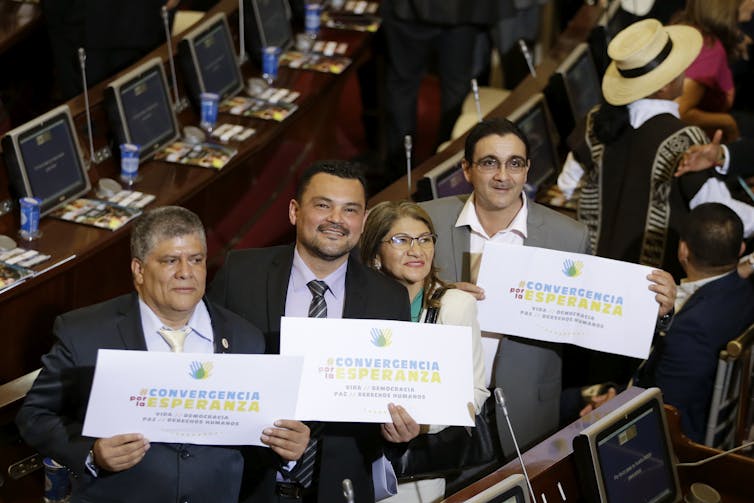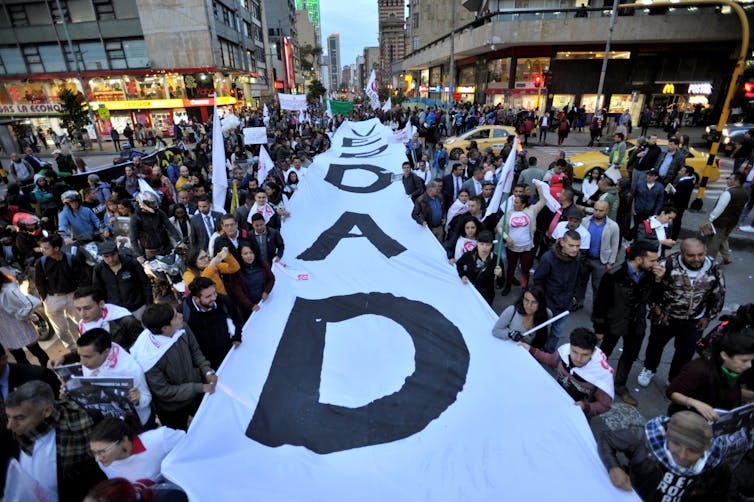Violence climbs in Colombia as president chips away at landmark peace deal with FARC guerrillas
- Written by Fabio Andres Diaz, Researcher on Conflict, Peace and Development, International Institute of Social Studies
Thousands of Colombian militants and soldiers will have their day in court.
A panel of judges ruled on May 29[1] that a special peace tribunal[2] established in Colombia’s landmark 2016 peace deal with the FARC guerrillas[3] must proceed under the agreed-upon terms. It cannot be altered to narrow its scope or make sentencing harsher, as Colombia’s new president, Ivan Duque, had requested[4].
Colombia’s transitional justice system[5], which resembles processes used in nations like South Africa and Guatemala[6], will judge FARC militants and members of the armed forces for crimes perpetrated during Colombia’s 52-year conflict. But the emphasis is on making amends for harm caused to civilians – not on punishing combat-related offenses, such as a guerrilla killing a soldier in combat.
Nearly all of the 6,804 FARC guerrillas who disarmed in 2016[7] and settled in government-run “reintegration camps” must now surrender themselves to the peace tribunal, swear to testify honestly and be interviewed by Colombia’s new truth commission[8].
Fighters who are determined not to have committed human rights violations during the conflict, and to have obeyed the law since the peace deal, may leave the reintegration camps to rejoin society. All others will be sentenced to jail or to community service in the areas they once terrorized.
This will happen despite the attitude of Duque, who thinks the transitional justice system[9] is too lenient. It is one of many provisions of the landmark Colombian peace deal he has moved to weaken, or even abandon, since taking office in August 2018.
Colombia’s best chance at peace
Colombia’s painstakingly negotiated peace agreement with the FARC – which won former Colombian President Juan Manuel Santos the 2016 Nobel Peace Prize[10] – ended the longest-running armed conflict in the Western Hemisphere. Fighting killed 200,000 people[11] and displaced 7 million[12] between 1964 and 2016.
But the deal was rejected at referendum[13] before being passed by Congress in November 2016, and it remains controversial.
Its goals include exposing and documenting the atrocities of the Colombian conflict, offering reparations to war victims[14] and revitalizing the long-neglected rural areas terrorized by different armed groups. It also aims to turn a Marxist insurgency into a political party[15] and to reconcile Colombians by reintegrating rebel fighters back into society[16].
 Former FARC guerrillas elected to Congress in Colombia celebrate their win, July 20, 2018.
AP Photo/Fernando Vergara[17]
Former FARC guerrillas elected to Congress in Colombia celebrate their win, July 20, 2018.
AP Photo/Fernando Vergara[17]
Conflict researchers like myself[18] have found that this comprehensive truth and justice process stands a good chance of bringing lasting peace and reconciliation[19].
At first, it seemed to be working.
Violence dropped markedly in 2017, Colombia’s safest year since 1975[20]. Social movements – long repressed[21] by a state that labeled all dissent as the seeds of insurgent rebellion – blossomed[22]. And a robust public debate began around corruption[23] and public services, both concerns long buried by militant violence.
A directionless peace process
Then Duque took office promising to “correct” Colombia’s peace agreement[24]. As a senator, he helped lead the “Vote No” initiative that narrowly derailed the accord[25] at referendum.
Under Duque’s leadership, the government’s progress on fulfilling its commitments to peace has slowed to nearly a standstill[26].
Duque has appointed “No” campaign loyalists to lead the agencies that must implement the agreement and left their budgets underfunded[27]. He has voiced opposition to a Santos administration commitment to help farmers who grow illegal coca leaf[28] transition to legal crops like coffee and ignored promises to boost economic investment in rural areas[29].
And Duque’s conservative Democratic Center party played a central role in vetoing a peace accord agreement that would have given more seats in Congress[30] to remote rural areas of Colombia – places so long neglected by the government that militant groups like the FARC controlled the territory.
The president’s foot-dragging comes after legislative delays[31] and last year’s election had already substantially slowed the peace process. One-third of the peace deal’s 578 provisions have not even begun to be implemented, according to Notre Dame University’s Kroc Institute for International Peace Studies[32].
Few provisions in Colombia’s peace deal have official deadlines or progress markers. That’s common in peace agreements, which after tense negotiations between warring sides tend to capture promises – not establish work plans[33].
Duque also appears to be considering a demand from the United States[34] to extradite FARC guerrillas[35] accused of involvement in international drug trafficking.
Currently, Colombian law only allows for the extradition of former guerrillas who committed drug crimes after the peace agreement was signed. Those who did so during the conflict, as a means to finance the FARC’s insurgency, will be dealt with through the transitional justice system.
The risks of a derailed peace
Members of the peace delegation that reached the FARC agreement[36] say the government’s actions compromise peace itself[37].
According to a recent Gallup poll[38], 55% of Colombians believe the government will not fulfill its commitments to the peace process. Sixty-two percent believe the FARC will not hold up its end of the deal.
 People in Bogotá protest President Ivan Duque’s decision to modify Colombia’s transitional justice system, March 19, 2019.
Reuters/Carlos Julio Martinez[39]
People in Bogotá protest President Ivan Duque’s decision to modify Colombia’s transitional justice system, March 19, 2019.
Reuters/Carlos Julio Martinez[39]
As trust between the two sides deteriorate, violence in Colombia is climbing.
Murders rose 3% in 2018[40], from 12,066 to 12,458. That figure includes a wave of attacks against activists, peasant organizers and Afro-Colombian community leaders[41] who have vocally defended the peace deal, 226 of whom were killed last year.
An estimated 1,700 former guerrillas have returned to armed struggle[42], joining one of Colombia’s many other militant groups, according to the think tank Fundacion Ideas Para la Paz[43]. Several high-profile leaders – including Ivan Marquez, who lead the FARC’s peace negotiations[44] – have gone into hiding.
In February, a bombing by the ELN guerrillas[45] in Bogotá killed 21 police personnel, confirming that domestic terrorism remains a threat in Colombia.
In response to climbing violence, Colombia’s armed forces have gotten more violent, too.
In early 2019, Major Gen. Nicacio Martínez Espinel ordered soldiers to “double the number of criminals they kill, capture or force to surrender,” The New York Times[46] has reported.
The reporting raised fear that Colombia would revert to the era of “false positives[47],” when members of Colombia’s armed forces in the early 2000s killed unarmed civilians, dressing their dead bodies in militant fatigues to meet their kill quota.
According to some estimates, soldiers murdered 10,000 innocent Colombians[48] to earn bonuses, holidays and promotions.
A long path to peace
Countries commonly suffer violence as they transition out of armed conflict, making strong political leadership[49] crucial for a peace process to succeed.
In post-apartheid South Africa[50], Nelson Mandela brought legitimacy to the country’s return to democracy. As its first black president, Mandela curbed political forces that opposed racial integration in South Africa and supported the truth and reconciliation process[51].
In doing so, Mandela made the prospect of peace seem real. He virtually willed it into being.
Colombia’s acrimonious post-accord government is leading the country in a different direction, empowering longtime opponents of the FARC accords and eroding the political capital of FARC leaders committed to peace. That increases the risk of relapsing violence that takes dangerous new forms[52].
War may not be imminent in Colombia. But neither, it now seems, is peace.
References
- ^ ruled on May 29 (amp.elespectador.com)
- ^ special peace tribunal (www.jep.gov.co)
- ^ 2016 peace deal with the FARC guerrillas (theconversation.com)
- ^ requested (www.economist.com)
- ^ transitional justice system (colombia2020.elespectador.com)
- ^ like South Africa and Guatemala (www.ictj.org)
- ^ disarmed in 2016 (lta.reuters.com)
- ^ truth commission (comisiondelaverdad.co)
- ^ transitional justice system (www.jep.gov.co)
- ^ 2016 Nobel Peace Prize (theconversation.com)
- ^ killed 200,000 people (www.independent.co.uk)
- ^ displaced 7 million (www.washingtonpost.com)
- ^ rejected at referendum (theconversation.com)
- ^ war victims (www.unidadvictimas.gov.co)
- ^ political party (theconversation.com)
- ^ reintegrating rebel fighters back into society (theconversation.com)
- ^ AP Photo/Fernando Vergara (www.apimages.com)
- ^ like myself (scholar.google.com)
- ^ bringing lasting peace and reconciliation (www.ictj.org)
- ^ safest year since 1975 (www.elespectador.com)
- ^ long repressed (theconversation.com)
- ^ blossomed (www.msn.com)
- ^ corruption (theconversation.com)
- ^ promising to “correct” Colombia’s peace agreement (theconversation.com)
- ^ narrowly derailed the accord (theconversation.com)
- ^ slowed to nearly a standstill (kroc.nd.edu)
- ^ budgets underfunded (colombia2020.elespectador.com)
- ^ help farmers who grow illegal coca leaf (www.dandc.eu)
- ^ promises to boost economic investment in rural areas (www.elcolombiano.com)
- ^ seats in Congress (www.elcolombiano.com)
- ^ legislative delays (theconversation.com)
- ^ Kroc Institute for International Peace Studies (kroc.nd.edu)
- ^ which after tense negotiations between warring sides tend to capture promises – not establish work plans (www.routledge.com)
- ^ demand from the United States (www.elespectador.com)
- ^ extradite FARC guerrillas (www.wradio.com.co)
- ^ delegation that reached the FARC agreement (www.rcnradio.com)
- ^ compromise peace itself (elpais.com)
- ^ recent Gallup poll (imgcdn.larepublica.co)
- ^ Reuters/Carlos Julio Martinez (pictures.reuters.com)
- ^ rose 3% in 2018 (www.eltiempo.com)
- ^ peasant organizers and Afro-Colombian community leaders (theconversation.com)
- ^ 1,700 former guerrillas have returned to armed struggle (www.eltiempo.com)
- ^ Fundacion Ideas Para la Paz (www.ideaspaz.org)
- ^ who lead the FARC’s peace negotiations (www.semana.com)
- ^ bombing by the ELN guerrillas (theconversation.com)
- ^ The New York Times (www.nytimes.com)
- ^ false positives (www.bbc.com)
- ^ murdered 10,000 innocent Colombians (www.theguardian.com)
- ^ strong political leadership (theconversation.com)
- ^ post-apartheid South Africa (www.bbc.com)
- ^ supported the truth and reconciliation process (theconversation.com)
- ^ relapsing violence that takes dangerous new forms (www.semana.com)
Authors: Fabio Andres Diaz, Researcher on Conflict, Peace and Development, International Institute of Social Studies

